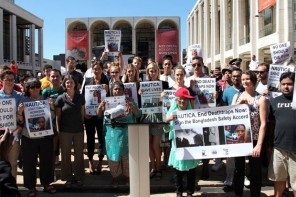Reducing your impact on the environment is an increasingly important part of bidding to host international events like the Olympics. WWF, for example, has been assessing the Olympics games since the Sydney 2000 Olympics and the NGO rates everything from environmental planning and evaluation to improvement of infrastructure, public transport and water conservation for the Olympics every four years.
Planning a green Olympics for London
Although it hasn’t been headline news, the WWF has been working to make the Olympic Games as green as possible for the past eight years. For the London 2012 Olympics, WWF partnered with BioRegional to influence discussions on the possibility of using carbon footprinting to create a plan for the greenest Olympics ever. WWF, BioRegional and London2012 have developed the concept of a “One Planet Olympics”.
When London bid to host this year’s Olympics, sustainability was at the core of its pitch. In 2007, the Olympic Delivery Authority (ODA) set out the following One Planet Olympic environmental targets:
- The Olympic village will be 25% more energy efficient
- Carbon emissions for the whole development will be 50% lower
- Renewable energy will provide 20% of the energy for the Olympic park and village
- The Olympic village will use 20% less water than average
- 20% of the materials used to construct the venues will be recycled
- 90% of demolished buildings will be recycled
- 50 miles of walking and cycle routes will be built around the Olympic park
The “One Planet Olympics” is a winning concept that made a few (admittedly vague) references to hosting a carbon neutral event. Most people realize that such a large event will never really be completely carbon neutral, which is why projects and events of this stature usually make use of carbon offsetting strategies (like funding a green project in a developing country) to offset their own carbon emissions.
Not everyone is happy about the sustainability strategies though. Robin Webster from Friends of the Earth NGO, for example, says that the carbon offsetting strategy is basically just “paying to pollute” and it’s not really sustainable.
“Offsetting is a false solution,” Webster told the Financial Times. “The focus needs to be on emissions reduction, both in the UK and abroad, rather than playing one country off another,” continue Webster.
According to Ecoincubation, the ODA has paid more than €1-million as an offset payment to deliver on the promise of a 50% cut in carbon footprinting. The money is going to London’s Renew scheme and it will help pay for insulation and energy efficient lighting in homes and schools in the area.
The Olympics Committee has now distanced itself from “carbon neutral” claims and is now using terms like “reducing” and “mitigating” the impact of the Olympic Games.
The renewable energy debate
EDF is the primary energy provider for the Olympic Games and besides the carbon-neutral Olympic Flame (which is a symbolic gesture), the power utility will also be providing 24MW of renewable energy for the event. While this sounds impressive, Financial Times also knocked the glory out of the situation by writing: “To put this figure into perspective, 24MW is only a single megawatt more than is needed to power a single square km of Central London. London, however, does have the highest load density in Europe.”
The original goal was that 20% of the energy would be from renewable sources. Richard Jackson from the ODA has been quoted saying that they will not meet this target.
“Beyond the huge sustainability benefits already delivered, we also set ourselves challenging targets on carbon reduction and renewable energy. Despite exhaustive efforts we have not been able to find a cost-effective solution to deliver a large percentage of renewable technology on the park,” said Jackson.
BBC reported that the ODA will only be able to provide 9% of the original 20% renewable energy target.
The good news
While it’s hard to find a lot of positive information about the environmental sustainability of the Olympic Games among all the criticism, there are definitely many great initiatives that have come from planning this event, such as the updated walking and cycling routes. £10-million has been sent on revamping London’s cycle and walking networks.
Approximately 75km of routes have been updated and it is predicted that an additional one million journeys will be made by foot and bike during the Olympics. People will be able to avoid congested roads and public transport and this will also help reduce pollution (not only during the games, but for years to come if Londoners continue to use these routes instead of their cars).
Another great success story is the venues. The Velodome Stadium, for example, is almost 100% naturally ventilated and it uses natural light to reduce energy consumption. Rain water will also be collected on the roof for flushing toilets and irrigation.
The different committees and builders have also been great about reusing waste materials. No materials leave the site if they can be reused or recycled in another way. During demolition phase, 97% of the material was reclaimed to be reused in the creation of the Olympic Park.
The assessments, evaluations and reports will undoubtedly start popping up a few months after the event. Regardless of whether the London 2012 Olympics reaches all their initial sustainability targets, the amount of planning and the commitment to execution will be a legacy for many Londoners for years to come.











